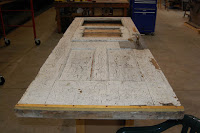 Artifact scholarship? Perhaps the gentle reader will now suggest that my name Spike references the additives in my coffee, but why shouldn’t we study the artifacts we care for? “Scholarship” is learning and the artifacts at the Northwest Railway Museum have many stories to tell, we just need to learn how to read them. Is our assumption of its origin correct? Was it really painted green? What was the number? Where was it made? Did it have 20 windows or 40? We can’t always answer these questions but often a study of the artifact can provide strong evidence as to the likelihood.
Artifact scholarship? Perhaps the gentle reader will now suggest that my name Spike references the additives in my coffee, but why shouldn’t we study the artifacts we care for? “Scholarship” is learning and the artifacts at the Northwest Railway Museum have many stories to tell, we just need to learn how to read them. Is our assumption of its origin correct? Was it really painted green? What was the number? Where was it made? Did it have 20 windows or 40? We can’t always answer these questions but often a study of the artifact can provide strong evidence as to the likelihood.
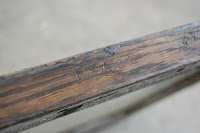 On March 28, 2009, noted wood rail car expert Glenn Guerra from Guerra Museum Services of Wisconsin visited the Museum to conduct a 4Culture-funded condition assessment and treatment plan for Chapel Car 5 Messenger of Peace. Messenger of Peace is already better documented than most objects in the collection, but it still has many secrets to reveal. Built in 1898, it is a true wood car and is a rare surviving example from the golden age of railcar construction.
On March 28, 2009, noted wood rail car expert Glenn Guerra from Guerra Museum Services of Wisconsin visited the Museum to conduct a 4Culture-funded condition assessment and treatment plan for Chapel Car 5 Messenger of Peace. Messenger of Peace is already better documented than most objects in the collection, but it still has many secrets to reveal. Built in 1898, it is a true wood car and is a rare surviving example from the golden age of railcar construction.
Take this apparently plain yet very heavy door from Messenger of Peace shown laying on a set of saw horses inside the CRC. A preliminary examination suggests it was constructed from white oak and has multiple coats of paint. A closer examination of the top edge finds a series of stampings, a common feature on railway car doors and windows because they were often removed at regular intervals for servicing.
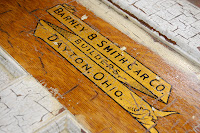 The experience of Glenn Guerra suggested sanding the paint off in the center of the door. Then more sanding, this time by hand with 320 grit wet/dry sand paper and mineral spirits. Still more sanding, still by hand but with 600 grit wet/dry sand paper and mineral spirits. Carefully, the surface was wiped with alcohol. (Earlier testing confirmed that the “original” finish was shellac and it will dissolve in alcohol but not mineral spirits.) About two hours were invested in this “scholarship” and the results are real and lasting: the now 111-year-old builder’s original guilded and hand lettered “name plate” has been identified, recorded and preserved.
The experience of Glenn Guerra suggested sanding the paint off in the center of the door. Then more sanding, this time by hand with 320 grit wet/dry sand paper and mineral spirits. Still more sanding, still by hand but with 600 grit wet/dry sand paper and mineral spirits. Carefully, the surface was wiped with alcohol. (Earlier testing confirmed that the “original” finish was shellac and it will dissolve in alcohol but not mineral spirits.) About two hours were invested in this “scholarship” and the results are real and lasting: the now 111-year-old builder’s original guilded and hand lettered “name plate” has been identified, recorded and preserved.

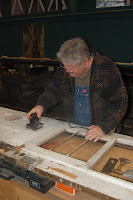
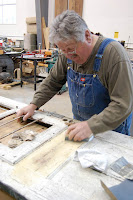
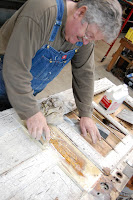

Wow!
As Harley Brumbah would say,” it is our critical choice, to preserve our collected wisdom or experience our collective amnesia.”
We are lucky to have the Museum in the valley and the expertise in preserving artifacts it brings.
Thanks for educating us all.
Jack Webber